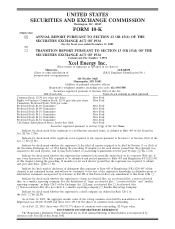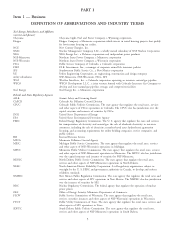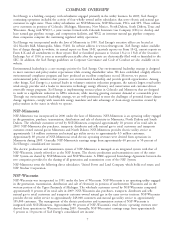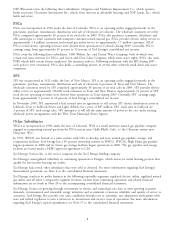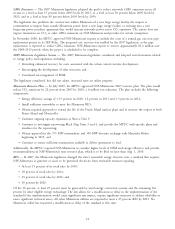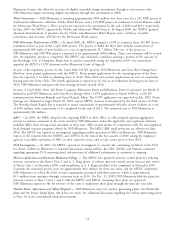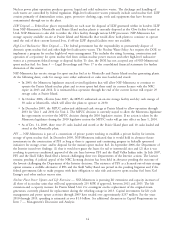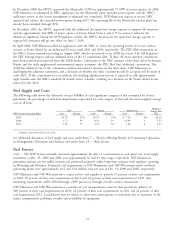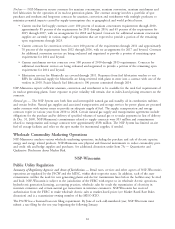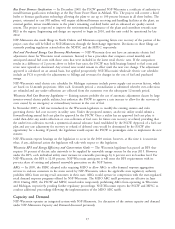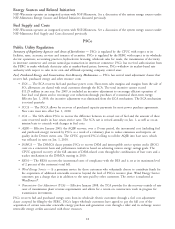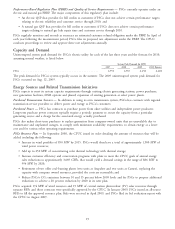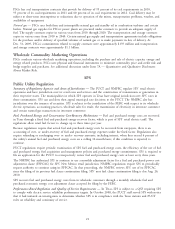Xcel Energy 2009 Annual Report Download - page 21
Download and view the complete annual report
Please find page 21 of the 2009 Xcel Energy annual report below. You can navigate through the pages in the report by either clicking on the pages listed below, or by using the keyword search tool below to find specific information within the annual report.
The FCAs allow NSP-Minnesota to bill customers for the cost of fuel and fuel related costs used to generate electricity
at its plants and energy purchased from other suppliers. In general, capacity costs are not recovered through the FCA.
In addition, costs associated with MISO are generally recovered through either the FCA or through rate cases.
NSP-Minnesota is required by Minnesota law to spend a minimum of 2 percent of Minnesota electric revenue on
conservation improvement programs. These costs are recovered through an annual cost-recovery mechanism for electric
conservation and energy management program expenditures. NSP-Minnesota is required to request a new cost-recovery
level annually. While this law changed to a savings-based requirement beginning in 2010, the costs of providing
qualified conservation improvement programs will continue to be recoverable through a rate adjustment mechanism.
MERP Rider Regulation — The MPUC approved a rate rider to recover prudent costs to convert two coal-fueled
electric generating plants to natural gas, and to install advanced pollution control equipment at a third coal-fired plant
beginning Jan. 1, 2006. A. S. King, High Bridge and Riverside went into service in July 2007, May 2008 and March
2009, respectively. In December 2009, the MPUC authorized the recovery of approximately $116.7 million in 2010
rates. The ROE for the A. S. King plant, the High Bridge plant and the Riverside plant, is 10.55 percent,
11.22 percent and 10.55 percent, respectively. The MERP projects will be included in rate base in the next general rate
case and the projects removed from the rider.
Capacity and Demand
Uninterrupted system peak demand for the NSP System’s electric utility for each of the last three years and the forecast
for 2010, assuming normal weather, is listed below.
System Peak Demand (in MW)
2007 2008 2009 2010 Forecast
NSP System .......................................... 9,427 8,697 8,615 9,280
The peak demand for the NSP System typically occurs in the summer. The 2009 uninterrupted system peak demand
for the NSP System occurred on June 23, 2009.
Energy Sources and Related Transmission Initiatives
NSP-Minnesota expects to use existing power plants, power purchases, DSM options, new generation facilities and
expansion of existing power plants to meet its system capacity requirements.
Purchased Power — NSP-Minnesota has contracts to purchase power from other utilities and independent power
producers. Capacity is the measure of the rate at which a particular generating source produces electricity. Energy is a
measure of the amount of electricity produced from a particular generating source over a period of time. Long-term
purchase power contracts typically require a periodic payment to secure the capacity from a particular generating source
and a charge for the associated energy actually purchased from such generating source.
NSP-Minnesota also makes short-term purchases to comply with minimum availability requirements, to obtain energy
at a lower cost and for various other operating requirements.
Purchased Transmission Services — In addition to using their integrated transmission system, NSP-Minnesota and
NSP-Wisconsin have contracts with MISO and regional transmission service providers to deliver power and energy to
the NSP System.
Excelsior Energy — In December 2005, Excelsior, an independent energy developer, filed a power purchase agreement
with the MPUC seeking a declaration that NSP-Minnesota be compelled to enter into an agreement to purchase the
output from two integrated gas combined cycle (IGCC) plants to be located in northern Minnesota as part of the
Mesaba Energy Project. The MPUC referred this matter to a contested case hearing before an ALJ to act on Excelsior’s
petition. The contested case proceeding considered a 600 MW unit in Phase 1 and a second 600 MW unit in Phase 2
of the Mesaba Energy Project.
In its August 2007 Phase 1 order, the MPUC found, among other things, that Excelsior and NSP-Minnesota should
resume negotiations toward an acceptable purchase power agreement, with assistance from the OES and the guidance
provided by the order.
In May 2009, the MPUC affirmed its previous order to deny Excelsior Energy’s Phase 2 request to approve a power
purchase agreement related to its proposed second 600 MW IGCC generating facility, which closed the docket. In
August 2009, Excelsior appealed the MPUC decision to the Minnesota Court of Appeals. The Minnesota Court of
Appeals heard arguments on Feb. 23, 2010, and a decision is anticipated in 2010.
11


